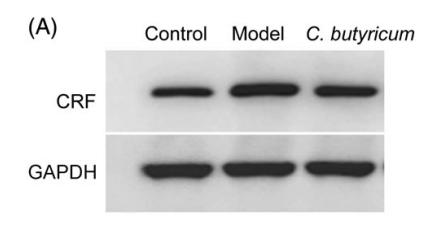CRH Antibody - #DF6258
| Product: | CRH Antibody |
| Catalog: | DF6258 |
| Description: | Rabbit polyclonal antibody to CRH |
| Application: | WB IHC |
| Reactivity: | Human, Mouse, Rat |
| Prediction: | Pig, Bovine, Sheep, Dog |
| Mol.Wt.: | 21kDa; 21kD(Calculated). |
| Uniprot: | P06850 |
| RRID: | AB_2838224 |
Related Downloads
Protocols
Product Info
*The optimal dilutions should be determined by the end user.
*Tips:
WB: For western blot detection of denatured protein samples. IHC: For immunohistochemical detection of paraffin sections (IHC-p) or frozen sections (IHC-f) of tissue samples. IF/ICC: For immunofluorescence detection of cell samples. ELISA(peptide): For ELISA detection of antigenic peptide.
Cite Format: Affinity Biosciences Cat# DF6258, RRID:AB_2838224.
Fold/Unfold
Corticoliberin; Corticotropin releasing factor; Corticotropin releasing hormone; CRF; Crh; CRH1;
Immunogens
- P06850 CRF_HUMAN:
- Protein BLAST With
- NCBI/
- ExPASy/
- Uniprot
MRLPLLVSAGVLLVALLPCPPCRALLSRGPVPGARQAPQHPQPLDFFQPPPQSEQPQQPQARPVLLRMGEEYFLRLGNLNKSPAAPLSPASSLLAGGSGSRPSPEQATANFFRVLLQQLLLPRRSLDSPAALAERGARNALGGHQEAPERERRSEEPPISLDLTFHLLREVLEMARAEQLAQQAHSNRKLMEIIGK
Predictions
Score>80(red) has high confidence and is suggested to be used for WB detection. *The prediction model is mainly based on the alignment of immunogen sequences, the results are for reference only, not as the basis of quality assurance.
High(score>80) Medium(80>score>50) Low(score<50) No confidence
PTMs - P06850 As Substrate
| Site | PTM Type | Enzyme | Source |
|---|---|---|---|
| S125 | Phosphorylation | Uniprot |
Research Backgrounds
Hormone regulating the release of corticotropin from pituitary gland (By similarity). Induces NLRP6 in intestinal epithelial cells, hence may influence gut microbiota profile (By similarity).
Secreted.
Produced by the hypothalamus and placenta.
Interacts (via C-terminus) with CRFR1 (via N-terminal extracellular domain).
Belongs to the sauvagine/corticotropin-releasing factor/urotensin I family.
Research Fields
· Human Diseases > Substance dependence > Alcoholism.
· Organismal Systems > Nervous system > Long-term depression.
References
Application: WB Species: mouse Sample: colonic
Restrictive clause
Affinity Biosciences tests all products strictly. Citations are provided as a resource for additional applications that have not been validated by Affinity Biosciences. Please choose the appropriate format for each application and consult Materials and Methods sections for additional details about the use of any product in these publications.
For Research Use Only.
Not for use in diagnostic or therapeutic procedures. Not for resale. Not for distribution without written consent. Affinity Biosciences will not be held responsible for patent infringement or other violations that may occur with the use of our products. Affinity Biosciences, Affinity Biosciences Logo and all other trademarks are the property of Affinity Biosciences LTD.

